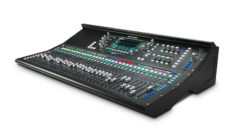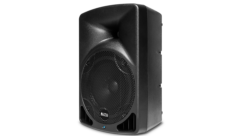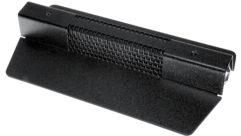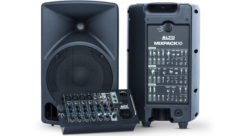
Technology Showcase:
Microphone Preamps
Sep 1, 2005 12:00 PM,
By Bennett Liles
New feature-rich, low-cost mic preamps fit today’s tight budgets.
Behringer Tube Ultragain Mic 100
In modern parlance, the terms “tight” and “budget” have, for practical purposes, become inextricably linked. In every field, maximum effort is being made to stretch available resources for maximum effect, and nowhere is this trend more evident than in the world of low-cost mic preamps. Products at this end of the price scale have developed new features and assets that can make the small sound shops sound much like the big ones. Versatility reigns supreme here, with tough road units that can also be rackmounted and serve studio and house sound systems with professional features.
Here, we explore the light end of the price scale, but as you will see, products light in price don’t have to be light in function. In the less-than-$500 price range we will find tube preamps, built-in limiters, continuously variable input and output gain controls, input and output metering, innovative sound character selection, multiple-channel configuration, selectable low-frequency rolloff, and combination connectors that save space without sacrificing versatility. From rugged roadsters to elegant, rackmounted studio pieces, the low-priced mic preamp market now offers something for every taste and talent. Products in this realm may be desired for the superior and subtle sound qualities they offer the discerning vocal recording artist, or they may be needed by the touring music truck, theater group, or sports van to bump mic levels above the noise and hum of AC motors and lighting dimmers. Whether you’re wearing tux, tights, or tennis shoes for the job, you’ll find a low-priced mic preamp that matches your mission.
THE OFFERINGS
The pocket-sized Ampetronic MP-101 mic preamp offers the ultimate in simplicity in an environment where small size and semi-permanent operational adjustments are paramount. Once the front-panel phantom power and gain switches are set, the unit may be installed in relatively inaccessible locations on the rear of rackmounted equipment. The gain from the balanced XLR input connector is switchable between 25dB and 40dB. When activated, the phantom power switch applies +15V and the unbalanced audio output is available on a 1/4in. jack at a maximum +20dBu. Input overload level is -20dBu, noise level is -127dBu with a 200Ω source, and input impedance is 5kΩ. The MP-101 uses 15V DC power on a three-pin mini DIN that can be supplied by an Ampetronic PS3 power supply or other regulated supply that puts +15V on pin one, -15V on pin two, and 0V on pin three. As a British product, the 230V power supply comes standard, but 115V versions may be ordered. Less than 2in. wide, this model is perfect for those mic pre applications in which you need to set it, mount it, and forget it. The retail price is less than $200.
The Aphex Systems Model 207 is a 2-channel, 1RU tube mic/instrument preamp that contains mic and instrument inputs with MicLim gain reduction circuitry on each channel. This optical attenuator is located at the mic input prior to the preamp. The circuit detects the preamp output and adjusts the input signal level to avoid clipping. The Reflected Plate Amplifier works as a single-triode differential op amp to provide classic warm tube sound without the heat, short life, and other problems associated with tubes. Another interesting feature is delayed turn on. The Power LED glows orange while the tube circuitry is stabilizing and turns green when ready. Another benefit of this is no turn on thumps. Also handy is an internal switch mode power supply that automatically senses and adapts to any power voltage, eliminating the need for external voltage selectors and jumpers. Mic inputs offer 20dB to 65dB continuously variable gain control, switchable 48V phantom power, 20dB pad, a low-cut filter, and polarity switches. Selectable -10dBv/+4dBu operating levels added to the XLR, and 1/4in. TRS input and output connectors, add even more versatility. The Model 207 lists for around $400.

Applied Research TPS II
The TPS II from Applied Research and Technology is a 1RU, 2-channel tube mic preamp that presents an impressive array of front-panel controls. These include a variable-input impedance control that only affects mic/line inputs to perfectly match any type of microphone, a +20dB gain switch, input gain control, output level control, a VU meter for analog tube output monitoring, a LED input meter for checking levels prior to amplification, a V3 (Variable Valve Voicing) selector that allows predetermined optimal settings for specific instruments, a phase reverse switch, and a 48V phantom power selector. Also featured is OPL (Output Protection Limiter) to prevent clipping, 5Hz to 50kHz frequency response, and 120dB dynamic range. The rear panel includes separate XLR and 1/4in. connectors, while the front panel offers combination input connectors to suit either type of cable hardware. The TPS II retails for an amazing $216.
Audio Technologies markets the M100 UltiMike high-performance microphone amplifier. This go-anywhere unit can be used freestanding and close to the source or rackmounted to get mic signals up to line level for noise-free transmission. The M100 features a 0dBu maximum mic input level, switchable 48V phantom power, phase reverse, limiter, a 150Hz low-cut filter, locally or remotely trimmable gain, and transformer-isolated output. Two units may be rackmounted beside each other using an accessory panel. A metal flange protects the external switches from inadvertent operation when the unit is bumped. The gain range is 0dB to 74dB, maximum output is +22dBm at 600Ω, and the noise figure is -70dBm from 20Hz to 20kHz. Harmonic distortion at maximum level is 10 percent, and nominal level is listed as .03 percent. Limiter attack and recovery time is 100ms, with a maximum slope of 4:1 and a threshold of +14dBm (+/- 1dB). The compact M100 measures 1.5″×8.5″×5.5″ and retails for about $400.
Vacuum tubes travel light in the Behringer Tube Ultragain Mic 100. The product, with integrated limiter, is intended for studio, live, and hard-disk recording applications and uses a 12AX7 for warm, vacuum tube sound and low noise. Transformerless, DC-coupled inputs and outputs are on gold-plated XLR and 1/4in. connectors. Controls include a 48V phantom power switch, phase reverse, and 20dB pad. Maximum output level is +26dBu at 100kΩ. Gain control is adjustable from +26dB to +60dB, and output is adjustable from infinity to +10dB. One handy feature is the panel-mounted, eight-segment, LED-input level meter, which indicates from -24 to +12, clipping, and power on. Smart features include LEDs that indicate operation of the 20dB pad, phantom power, phase reverse, and limiter. Otherwise, the positions of the small activation buttons would be difficult to interpret at a glance. All these features add up to a substantial package for a retail price of $60.
Another pick-it-up-and-go mic preamp is the 2-channel Mic-Man Jr. from Benchmark Media Systems. This amazingly small package is powered by two 9V and two 1.5V batteries or by an external 16V supply. The front-panel controls enable from 26dB to 82dB gain over a 160kHz bandwidth and include 12V phantom mic power (on pins two and three with return on pin one), battery on-off, and an external power switch. Input impedance is 1.818kΩ, and output impedance is 60Ω, with 150Ω and 600Ω available on special order. For rackmounting, the knobs and front bezel are removed. The rackmount bezel replaces the standalone bezel, and the knobs are re-installed. The unit comes with an external PS-1 power supply, but the PS-4 power supply is also available for adjacent rackmounting and powering up to four Mic-Man Jr. units. The product lists for $435.

Crest Performance Ipro One
Crest Performance, a division of Crest Audio, introduces the iPro One microphone and line input intelligibility processor. This unit combines a parametrics (EQ) section and a compand/limit (dynamics) section to optimize sound signals for recording, broadcast, and live performance.
The parametric section features two selectable-band cut/boost adjustments. The boost/cut is +12dB/-24dB for notching out noise. The selected band can be incremented from 1/6 to two octaves for a wide range of effects. Each equalizer can be switched in or out, and EQ can be switched into the side chain insert of the RMS detector to control the frequencies that activate the dynamics — extremely sophisticated feature for a unit in this price range. The switchable dynamics section has ratio and threshold controls and a limiter with threshold control. The noise reduction topology can be adjusted for gating or gentle-slope, indicated by a threshold LED. The adjustable SmarTube processor assures a tubelike response on each of the two balanced inputs: a low-impedance XLR and a high-Z 1/4in. connector. Also included are 48V phantom power, polarity reverse, and 20dB pad, as well as an array of control options. The iPro One lists for around $500.

Focusrite OctoPre LE
The OctoPre LE from Focusrite boasts an 8-channel preamp with a slew of features for this price range. The 1RU system offers mic, line, and instrument inputs and a porthole-style peak reading meter that is switchable to display the input level of any of the eight channels. An additional overload LED on each channel triggers at +22dBu. Included are two “super channels,” which add DI for electrified instruments and low-impedance matching, or deliberate mismatching, of low-impedance mics. All-channel 48V phantom power and phase reverse are available, and each channel has a 12dB/octave low-cut filter. Mic gain is variable from +13dB to +60dB with a maximum frequency response of 122kHz. Electronically balanced mic and line inputs are accessed via eight XLR connectors for mic and 25-pin D type for analog line sources. Channels one and two also include 1/4in. TRS jacks on the front panel for instrument sources. Outputs have eight 1/4in. TRS jacks on the rear panel. Without the optional A/D-D/A converter unit, the OctoPre LE sells for just less than $500.
The Mini-Pre vacuum tube microphone preamp from dbx Professional Products adds a crucial aspect of portability to the company’s established line of excellent microphone preamps. The Mini-Pre uses a 12AX7 tube and includes switchable 48V phantom power, 20dB pad, a phase reverse switch, 60dB gain, and an output level of infinity to +10dB. Inputs include XLR mic (2kΩ) and 1/4in. tip/sleeve line (>1MΩ), while outputs feature XLR and balanced TRS 1/4in. jacks. The attractive panel display includes LEDs for power on and peak indicator. A maximum output level of +21dBu is provided on the 1/4in. output connector. The Mini-Pre retails for about $100.
One of the most compact 2-channel mic preamps may be found in the Audio Buddy from M-Audio, a business unit of Avid. Each channel has a 1/4in. unbalanced, high-impedance input; a low-impedance XLR mic input; and independent gain control with signal/clip LEDs. The Audio Buddy sports a frequency response of 5Hz to 50kHz (+0/-3dB), 60dB maximum mic input gain, and 40dB maximum instrument gain in a tiny package that weighs less than 8oz. Mic input impedance is1kΩ, and instrument input impedance is 100kΩ. Panel indicators include LEDs for main and phantom power, and individual channel signal and clipping LEDs. Outputs are 1/4in. balanced/unbalanced connectors. Whenever one of the high-impedance inputs is used, the phantom power and the corresponding XLR input connector are disabled. When the phantom power is used, it is switched into both XLR inputs. Power is supplied at a rear connector by an external 9V, 500-milliamp power adapter. The Audio Buddy lists for $120.
PreSonus Audio Electronics offers a feature-packed, 2-channel preamp called the BlueTube DP that, unlike most small, low-priced products, includes dual backlit analog VU meters. The BlueTube DP has a dual path feature with a vacuum tube stage and a solid-state stage on each channel, each offering its own characteristic response. Phantom power of 48V, 20dB pad, phase reverse, and an 80Hz rolloff can be independently assigned to each channel. Versatility extends to the inputs, which feature Neutrik Combo connectors to accommodate either XLR (1.3kΩ) or 1/4in. (1MΩ) hardware. Each channel also has a tube drive potentiometer for control of the 12AX7 vacuum tube stage. The separate gain controls can be used to adapt the unit’s operation for best levels from condenser microphones and from lower-output dynamic mics and instruments. The tube drive control can be used to achieve a variety of sound response tonal patterns. Outputs are available on balanced XLR and unbalanced 1/4in. tip/sleeve connectors. The external power supply provides 16VAC at 1 amp for 16W consumption. The BlueTube DP weighs 4lbs. and retails for less than $200.
For the most basic preamp needs in a single-channel unit, the Rane MS 1b has the simplicity and small size required. The unit features a balanced XLR input (10kΩ) with a 48V phantom power switch; 18dB to 66dB adjustable gain from a Burr-Brown mic preamp chip; a signal/overload LED; a polarity switch; and a high-current, cross-coupled output line driver with a balanced XLR output connector. The power connector is an RJ telephone type and provides no grounding, so there is a grounding screw located on the rear chassis. Also on the rear panel are a polarity reversal switch and a balanced XLR line output connector. The MS 1b also provides a 50Ω output impedance for driving lines up to 1,000ft. It offers a maximum dynamic range of 120dB, frequency response of 45Hz to 200kHz (+0dB/-3dB), and a maximum signal-to-noise ratio of 96dB. An 18VAC power supply is included, and the unit draws about 220 milliamps. The MS 1b lists for around $200.
The Shure FP23 battery-powered, single-channel mic preamp has proven itself as a feature-packed and durable road unit. Balanced XLR inputs and outputs complement other features, such as selectable 12V and 48V phantom power, a low-frequency rolloff switch (switchable from 80Hz to 160Hz at 6dB/octave), transformer isolation, RF filtering, a low-battery LED indicator, a switchable limiter, and 66dB of gain in selectable steps for accurate gain matching between units. The FP23 is in its element when there is a low-level mic signal to be boosted for long-line conveyance through an electrically noisy environment. The product provides a 122dB dynamic range at the +18dB gain setting and 24 hours of operation from two AA batteries with phantom power off. The built-in limiter uses dual opto-isolators and holds output level to +17dBu through a 10:1 limiting ratio using a 5ms attack time and 100ms release time. An LED indicator shows amber in limiting and red when clipping occurs. The green power LED turns red when four hours of battery power remain.
Another road warrior in the microphone preamp world is the MP-1 from Sound Devices. This tough little preamp features long-duration power from two AA batteries; a selectable, three-position, low-frequency rolloff switch with 80Hz to 160Hz at 6dB/octave; and flat settings. An extruded aluminum chassis with protective metal end rails affords high RF-interference rejection. Also featured are transformer-balanced XLR inputs and outputs and 66dB gain in 11 selectable steps. The frequency response is 22Hz to 22kHz (+0.1dB/-0.5dB) and at the 0dB or +18dB gain setting, the input clipping level is +4dBu minimum, and the dynamic range is 122dB minimum. The input impedance is 2,000Ω, and the output impedance is 130Ω. The green power LED turns red when battery power is low. The MP-1 weighs 1.24lbs. and lists for less than $300.

Symmetrix 302
The Symetrix 302 dual microphone preamp offers individual, continuously variable channel gain settings from 20dB to 60dB combined with a switchable 15dB pad to handle input levels up to +14dBv. Each channel also has a polarity reverse button and a red LED that lights when the input signal reaches 3dB below clipping. The 48V phantom power switch applies the voltage to pins two and three on both inputs, and the input impedance is less than 3kΩ. The rear panel is somewhat unusual because it contains a seven-pin power connection for the separate Symetrix SP-3 or PS-3e power supplies and Euroblock connectors for balanced output connections in more permanent installations. There are separate output blocks for each channel and a center block for combined output summing both channels. Also available are 1/4in. tip/ring/sleeve phone jacks carrying each channel’s output signal at a maximum +24dBu for a 10kΩ load and +22dBu for a 6,600Ω load. The Symetrix 302 lists for less than $300.
For More Information
Ampetronic
www.ampetronic.com
Aphex Systems
www.aphex.com
Applied Research and Technology
www.artroch.com
Audio Technologies
www.atiguys.com
Behringer
www.behringer.com
Benchmark Media Systems
www.benchmarkmedia.com
Crest Performance
www.crest-performance.com
dbx Professional Productswww.dbxpro.com
Focusrite Audio Engineering
www.focusrite.com
M-Audio
www.m-audio.com
Presonus Audio Electronics
www.presonus.com
Ranewww.rane.com
Shure
www.shure.com
Sound Devices
www.sounddevices.com
Symetrix
www.symetrixaudio.com










